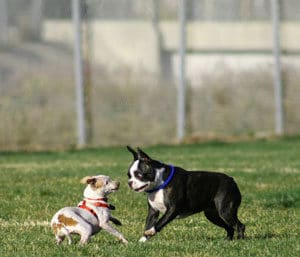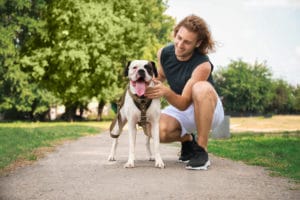
Just like a “wimpy kid” in middle school, you’ll know if your dog is getting bullied if, in social settings like the dog park, it gets frequently mounted, has food, water, toys, or spots stolen, gets ganged up on, or even gets badly injured. Its response to other dogs will often seem intimidated and defensive — even before any other dogs “act out.” For instance, as soon as they are approached by another dog, they may cower or immediately roll on their back, exposing their belly and showing submission.
Dogs that get picked on “in public” may otherwise be happy and well-adjusted at home, but they may also display signs of being overly submissive. If your dog is overly submissive at home, you may need to help raise its sense of status with you, while still understanding that you are the pack leader.
For example, when you greet your dog, squat or sit, as getting closer to the floor will help raise its status. Avoid petting your dog on the head — rather pet it or scratch it under the chin to provide a sense of “dignity” and self-confidence.
If your dog displays overly submissive behaviors like rolling on its back or urinating in an interaction, it’s best to avoid eye contact, ignore your dog and walk away when such behaviors occur. After about five minutes or so, get near the floor, and call your dog to you with a treat. In cases where dogs are too submissive, it’s important to never compound their fear by using negative methods of discipline.
If your “wimpy kid” dog is otherwise content and confident at home and with people, it’s not a bad idea to get it some social training — either at an obedience school or with well-balanced, well-led dogs who can help it feel safe among peers. The more positive social experiences your dog can get, the more conditioned it will be to know that it’s not meant for victimhood.
That said, in general, don’t take your dog to the dog park if your dog doesn’t enjoy it simply because of its hard-wired temperament. Make sure, also, that your dog is mature and trained enough for the dog park environment. If you do go, you should remain alert and aware, showing your dog that you are still pack leader. Supervise its play, and be ready to call it to you if it gets picked on. Try to stay out of the middle and focus on getting your dog out of harm’s way.
In the case of having a dog that gets picked on repeatedly by another one of your own pets, you might want to focus on disciplining and training the more aggressive pet. Teaching the more submissive dog to stand up for itself is unlikely when you are dealing with shared territory. Both pets must know that you are the pack leader and have set a standard for harmony in your environment.
Overall, by prioritizing your dog’s sense of safety, you can minimize its fearful tendencies and increase its sense of self-esteem and stability.










